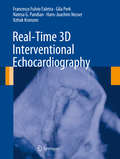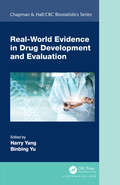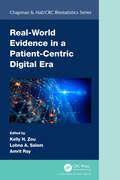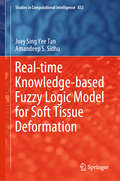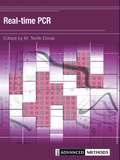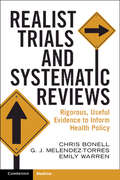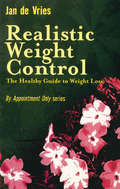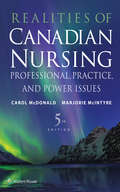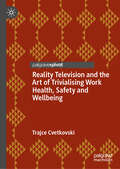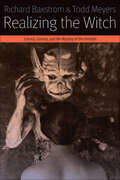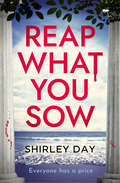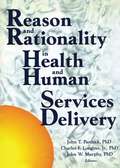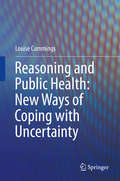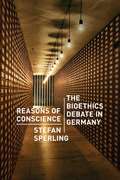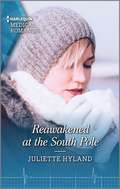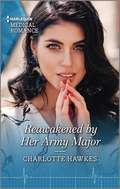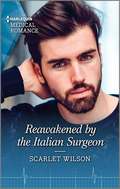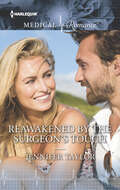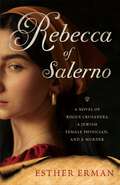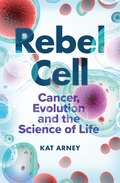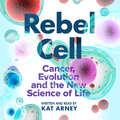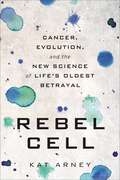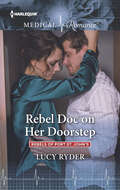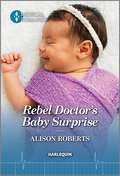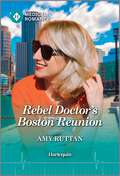- Table View
- List View
Real-Time 3D Interventional Echocardiography
by Hans-Joachim Nesser Natesa G. Pandian Itzhak Kronzon Francesco Fulvio Faletra Gila PerkAdvances in technology and human skill have made possible percutaneous catheter-based procedures for a wide spectrum of structural heart disease. A growing number of structural heart diseases that over the past two decades would have required open heart surgery can be safely treated using percutaneous catheter-based procedures. Traditionally, guidance of catheter-based procedures is done using fluoroscopy and two-dimensional transesophageal echocardiography (2D TEE). The recent introduction in the clinical practice of RT 3D TEE has overcome most of limitations of 2D TEE. The purpose of this book is to describe the use of this imaging modality in percutaneous interventional procedures underlying its growing role and acceptance among the interventional cardiologists but also emphasizing areas of weakness. Because today interventional cardiology ranges from closure of atrial and ventricular septal defects, to repair of mitral regurgitation and aortic stenosis, from the closure of left atrial appendage and prosthesis dehiscence, to the recent use in electrophysiological procedure, this book targets not only specialists in echocardiography and interventional cardiology but also general cardiologists. General cardiologists will find in any chapter anatomy of the structure treated (i. e. atrial septum, mitral valve. . . ), a description of the morphopathology as seen with RT 3D TEE (degenerative or ischemic mitral regurgitation) the up-to-date indications to the specific percutaneous treatment and typical and unusual clinical cases.
Real-World Evidence in Drug Development and Evaluation (Chapman & Hall/CRC Biostatistics Series)
by Harry Yang Binbing YuReal-world evidence (RWE) has been at the forefront of pharmaceutical innovations. It plays an important role in transforming drug development from a process aimed at meeting regulatory expectations to an operating model that leverages data from disparate sources to aid business, regulatory, and healthcare decision making. Despite its many benefits, there is no single book systematically covering the latest development in the field.Written specifically for pharmaceutical practitioners, Real-World Evidence in Drug Development and Evaluation, presents a wide range of RWE applications throughout the lifecycle of drug product development. With contributions from experienced researchers in the pharmaceutical industry, the book discusses at length RWE opportunities, challenges, and solutions. Features Provides the first book and a single source of information on RWE in drug development Covers a broad array of topics on outcomes- and value-based RWE assessments Demonstrates proper Bayesian application and causal inference for real-world data (RWD) Presents real-world use cases to illustrate the use of advanced analytics and statistical methods to generate insights Offers a balanced discussion of practical RWE issues at hand and technical solutions suitable for practitioners with limited data science expertise
Real-World Evidence in a Patient-Centric Digital Era (Chapman & Hall/CRC Biostatistics Series)
by Amrit Ray Kelly H Zou Lobna A. SalemReal-world evidence is defined as evidence generated from real-world data outside randomized controlled trials. As scientific discoveries and methodologies continue to advance, real-world data and their companion technologies offer powerful new tools for evidence generation. Real-World Evidence in a Patient-Centric Digital Era provides perspectives, examples, and insights on the innovative application of real-world evidence to meet patient needs and improve healthcare, with a focus on the pharmaceutical industry. This book presents an overview of key analytical issues and best practices. Special attention is paid to the development, methodologies, and other salient features of the statistical and data science techniques that are customarily used to generate real-world evidence. It provides a review of key topics and emerging trends in cutting-edge data science and health innovation. Features: Provides an overview of statistical and analytic methodologies in real-world evidence to generate insights on healthcare, with a special focus on the pharmaceutical industry Examines timely topics of high relevance to industry such as bioethical considerations, regulatory standards, and compliance requirements Highlights emerging and current trends, and provides guidelines for best practices Illustrates methods through examples and use-case studies to demonstrate impact Provides guidance on software choices and digital applications for successful analytics Real-World Evidence in a Patient-Centric Digital Era will be a vital reference for medical researchers, health technology innovators, data scientists, epidemiologists, population health analysts, health economists, outcomes researchers, policymakers, and analysts in the healthcare industry.
Real-time Knowledge-based Fuzzy Logic Model for Soft Tissue Deformation (Studies in Computational Intelligence #832)
by Amandeep S. Sidhu Joey Sing TanThis book provides a real-time and knowledge-based fuzzy logic model for soft tissue deformation. The demand for surgical simulation continues to grow, as there is a major bottleneck in surgical simulation designation and every patient is unique. Deformable models, the core of surgical simulation, play a crucial role in surgical simulation designation. Accordingly, this book (1) presents an improved mass spring model to simulate soft tissue deformation for surgery simulation; (2) ensures the accuracy of simulation by redesigning the underlying Mass Spring Model (MSM) for liver deformation, using three different fuzzy knowledge-based approaches to determine the parameters of the MSM; (3) demonstrates how data in Central Processing Unit (CPU) memory can be structured to allow coalescing according to a set of Graphical Processing Unit (GPU)-dependent alignment rules; and (4) implements heterogeneous parallel programming for the distribution of grid threats for Computer Unified Device Architecture (CUDA)-based GPU computing.
Real-time PCR (Advanced Methods)
by M. Tevfik DorakWith a variety of detection chemistries, an increasing number of platforms, multiple choices for analytical methods and the jargon emerging along with these developments, real-time PCR is facing the risk of becoming an intimidating method, especially for beginners. Real-time PCR provides the basics, explains how they are exploited to run a real-time PCR assay, how the assays are run and where these assays are informative in real life. It addresses the most practical aspects of the techniques with the emphasis on 'how to do it in the laboratory'. Keeping with the spirit of the Advanced Methods Series, most chapters provide an experimental protocol as an example of a specific assay.
Realist Trials and Systematic Reviews: Rigorous, Useful Evidence to Inform Health Policy
by Chris Bonell G. J. Melendez-Torres Emily WarrenThis book describes an innovative approach to the evaluation of complex health interventions, assessing what interventions work, how and for whom. Rejecting the stalemate between trials and realist evaluation, it draws on the best of both. Randomised controlled trials and systematic reviews offer the least biased means of assessing intervention effects but tell us little scientifically about how interventions work. Policy-makers and practitioners are also not supported to decide which interventions are likely to achieve most benefits in their local contexts. Realists use other forms of evaluation and evidence synthesis exploring how intervention mechanisms interact with context to generate outcomes. But these approaches lack rigour in assessing causality. This book proposes how realist evaluation methods may be incorporated within randomised controlled trials and systematic reviews. This enables evaluations and evidence synthesis to benefit from the more nuanced questions posed within realist enquiry while maintaining rigour in assessing causality.
Realistic Weight Control: The Healthy Guide to Weight Loss
by Jan de VriesWhatever you might call it - being overweight or corpulent or carrying excess fat - one thing is certain: obesity is one of the major problems of the developed world today. It is not simply a matter of being too fat: those who are severely overweight are prone to a tremendous range of other health problems such as back pain and coronary heart disease. In Realistic Weight Control Jan de Vries clearly and sensibly explains why these problems occur and how best to avoid them. Moreover, in view of the overwhelming variety of slimming methods on the market, each claiming to be better than the last, he points out the dangers to health caused by following an inappropriate diet.
Realities of Canadian Nursing: Professional, Practice, and Power Issues
by Carol McDonald Marjorie McIntyreIn Realities of Canadian Nursing, influential scholars throughout Canada give voice to the unheard concerns of nurses and go to great lengths to ensure the text offers readers more than an update on current and pressing professional, legal, ethical, political, social, economic, and environmental issues in nursing and healthcare. In chapter 1 of the text, authors Carol McDonald PhD, RN and Marjorie McIntyre RN, PhD offer a Framework for Analysis, which gives students and educators a shared and organized format through which to identify, analyze, and strategize about solving the issues. Students will be inspired to influence professional associations, collective bargaining units, government, and workplace and participate in political action. In this edition, the authors will retain the content and features that have made this text the mostly widely used issues and trends book in the Canada, while adding new coverage of Canada’s Truth and Reconciliation Commission (TRC) and the subsequent Calls to Action. Student and Instructor resources on thePoint will help prepare students for the NCLEX and help faculty save time as well as integrate their course resources with their required text.
Reality Television and the Art of Trivialising Work Health, Safety and Wellbeing
by Trajce CvetkovskiThis book aims to assess the extent to which work health, safety and wellbeing (HSW) considerations are trivialised on the popular Australian reality TV programme, The Block. Reality TV as a genre plays a core feature in media and cultural studies, but there has not been any research on the impact of reality TV on safety culture, or how HSW issues are portrayed in popular media. This research remedies this deficiency and demonstrates contestants are workers on The Block who perform workplace activities. The work-related activities are concerned with construction, building and renovation work; and specifically, participants engage in what are seemingly routine or ordinary everyday life activities; namely housing construction and domestic or home dwelling renovations. It supports the argument claim that contestants on reality TV are defined as workers, and this definition of worker can be extended to other genres. The book ultimately demonstrates that reality television is trivialising HSW for the purposes of satisfying audience desire to consume popular culture, and these activities perpetuate a poor image of best safety practice.
Realizing the Witch: Science, Cinema, and the Mastery of the Invisible (Forms of Living)
by Richard Baxstrom Todd MeyersBenjamin Christensen’s Häxan (The Witch, 1922) stands as a singular film within the history of cinema. Deftly weaving contemporary scientific analysis and powerfully staged historical scenes of satanic initiation, confession under torture, possession, and persecution, Häxan creatively blends spectacle and argument to provoke a humanist re-evaluation of witchcraft in European history as well as the contemporary treatment of female “hysterics” and the mentally ill.In Realizing the Witch, Baxstrom and Meyers show how Häxan opens a window onto wider debates in the 1920s regarding the relationship of film to scientific evidence, the evolving study of religion from historical and anthropological perspectives, and the complex relations between popular culture, artistic expression, and concepts in medicine and psychology. Häxan is a film that travels along the winding path of art and science rather than between the narrow division of “documentary” and “fiction.” Baxstrom and Meyers reveal how Christensen’s attempt to tame the irrationality of “the witch” risked validating the very "nonsense" that such an effort sought to master and dispel. Häxan is a notorious, genre-bending, excessive cinematic account of the witch in early modern Europe. Realizing the Witch not only illustrates the underrated importance of the film within the canons of classic cinema, it lays bare the relation of the invisible to that which we cannot prove but nevertheless “know” to be there.
Reap What You Sow
by Shirley DayIn this suspenseful thriller, a journalist writing about a reclusive billionaire finds herself caught in a madman&’s maze. Sophie regrets leaving her much-loved ex-boyfriend over Christmas, but she can&’t pass up the opportunity of a lifetime: writing a personal history for the enigmatic billionaire Tim Henderson. A pioneer in the early days of fertility treatment, Henderson now lives a reclusive life on his private Greek island. Sophie soon discovers that the ancient labyrinth on Henderson&’s property has a dark history, steeped in myth and legend. Even more worrying is the island&’s equally sinister present. Can Sophie find a way out of Henderson&’s delusional trap before her future is destroyed?
Reason and Rationality in Health and Human Services Delivery
by John W Murphy Jean A Pardeck Charles Longino, JrReason and Rationality in Health and Human Services Delivery is the first book to discuss the topic of decisionmaking and services from a multidisciplinary approach. It uses theory and social considerations, not just technology, as a basis for improved services. Health and human service students and professionals will learn how to form rational and reasonable decisions that take their clients’cultural backgrounds into consideration when identifying an illness or appropriating any kind of intervention. With a particular emphasis on theories, models, organizational settings, technologies, and practitioner training methods that lead to culturally sensitive decisions, Reason and Rationality will help you deliver efficient and improved medical and social services to clients from all ethnic backgrounds. Recognizing reason as the centerpiece of most of Western philosophy, this text reveals how our idea of truth, fact, and order are wrongly thought to be universal; yet, Western principles are continually used in the decision-making process for health and social services. Focusing on the policy implications of decisionmaking in medical and social service settings, this text works to incorporate a broad range of factors into the reasoning process, such as cultural traditions and beliefs, that will result in better treatment for patients. Giving you suggestions and strategies for upgrading reasoning and decision-making processes and applying them to every area of service, Reason and Rationality discusses different themes that will help you improve services to patients, such as: the rationale currently used to justify decision-making strategies concerning medical and human services using computer technology to make clinical assessments revising administrative structure, management theories, and organizational strategies so that decision-making processes enhance the overall quality of service delivery how the practitioner/patient relationship is important in choosing the proper treatment soliciting community-based input to assess the public’s health and human service needs in order to lessen political involvement in decision-making stages In addition, Reason and Rationality provides information and examples that show why you should consider the “life-world”--the values, beliefs, and commitments of a culture’s history-- as the key to understanding the powers of reasoning that specify parameters of health and illness.
Reasoning and Public Health: New Ways of Coping with Uncertainty
by Louise CummingsThis book argues that in order to be truly effective, public health must embrace a group of reasoning strategies that have traditionally been characterized as informal fallacies. It will be demonstrated that these strategies can facilitate judgements about complex public health issues in contexts of uncertainty. The book explains how scientists and lay people routinely resort to the use of these strategies during consideration of public health problems. Although these strategies are not deductively valid, they are nevertheless rationally warranted procedures. Public health professionals must have a sound understanding of these cognitive strategies in order to engage the public and achieve their public health goals. The book draws upon public health issues as wide ranging as infectious diseases, food safety and the potential impact on human health of new technologies. It examines reasoning in the context of these issues within a large-scale, questionnaire-based survey of nearly 900 members of the public in the UK. In addition, several philosophical themes run throughout the book, including the nature of uncertainty, scientific knowledge and inquiry. The complexity of many public health problems demands an approach to reasoning that cannot be accommodated satisfactorily within a general thinking skills framework. This book shows that by developing an awareness of these reasoning strategies, scientists and members of the public can have a more productive engagement with public health problems.
Reasons of Conscience: The Bioethics Debate in Germany
by Stefan SperlingThe implicit questions that inevitably underlie German bioethics are the same ones that have pervaded all of German public life for decades: How could the Holocaust have happened? And how can Germans make sure that it will never happen again? In "Reasons of Conscience," Stefan Sperling considers the bioethical debates surrounding embryonic stem cell research in Germany at the turn of the twenty-first century, highlighting how the countryOCOs ongoing struggle to come to terms with its past informs the decisions it makes today. aaaaaaaaaaaSperling brings the reader unmatched access to the offices of the German parliament to convey the role that morality and ethics play in contemporary Germany. He describes the separate and interactive workings of the two bodies assigned to shape German bioethicsOCothe parliamentary Enquiry Commission on Law and Ethics in Modern Medicine and the executive branchOCOs National Ethics CouncilOCotracing each institutionOCOs genesis, projected image, and operations, and revealing that the content of bioethics cannot be separated from the workings of these institutions. Sperling then focuses his discussion around three core categoriesOCotransparency, conscience, and Germany itselfOCoarguing that without fully considering these, we fail to understand German bioethics. He concludes with an assessment of German legislators and regulatorsOCO attempts to incorporate criteria of ethical research into the German Stem Cell Law. "
Reawakened at the South Pole
by Juliette HylandAn antarctic adventureand a reunion of a lifetime…ER nurse Helena Mathews wants just one thing: to show her parents that she&’s no longer the fragile, premature baby they cradled in the NICU. So her new South Pole–based job is the perfect way to break free! But Dr. Carter Simpson&’s arrival proves that you can&’t just erase the past. Her one-time best friend may have left without a trace after a life-altering discovery, but he never left Helena&’s heart… &“Oh this was just perfect! I loved a good medical romance and Hyland has truly delivered a goodie with The Pediatrician&’s Twin Bombshell! I loved every bit…this was just the type of book that you don&’t want to put down because it just keeps getting better. If you enjoy a good fast paced medical romance, then this is the book for you!&”-Harlequin Junkie &“An emotionally intense love story! Juliette Hyland shines once again…. Her characters are richly developed with intriguing back stories and the mix of medical situations with the budding romance is always spot on. Always looking forward to more from this endearing voice. I highly recommend this book to anyone who enjoys a medical setting with complex characters, emotional interactions and a well-deserved happily ever after.&”-Goodreads on A Stolen Kiss with the Midwife
Reawakened by Her Army Major: Second Chance With His Army Doc (reunited On The Front Line) / Reawakened By Her Army Major (reunited On The Front Line) (Reunited on the Front Line #2)
by Charlotte HawkesCould their one night together…Change everything?When playboy army major Hayden Brigham meets innocent nurse Bridget Gardiner in a nightclub, the chemistry between them is impossible to ignore! But when they must then work together in a hostile and challenging environment, it means keeping their focus on the job! Being under fire only brings them closer…but is Bridget ready to accept that their relationship could survive beyond their mission?From Harlequin Medical: Life and love in the world of modern medicine.Reunited on the Front LineBook 1: Second Chance with His Army DocBook 2: Reawakened by Her Army Major
Reawakened by the Italian Surgeon (Double Miracle at St. Nicolino's Hospital #2)
by Scarlet WilsonTop surgeon, devoted single dad…the doctor to open her heart?Flying to Rome to separate conjoined twins is just the fresh start that Autumn needs. Her latest breakup has proved that her heart belongs only to surgery. But lead surgeon and widower Giovanni Lombardi has her pulse racing, and his adorable daughter awakens a longing for a family Autumn never thought she wanted—until now…A Double Miracle at St Nicolino's Hospital novel Double Miracle at St Nicolino's Hospital duetBook 1 - A Family Made in Rome by Annie O&’NeilBook 2 – Reawakened by the Italian Surgeon by Scarlet Wilson &“His Blind Date Bride was a solid romance that flowed well from beginning to end. Ms. Wilson did a great job of showing the buildup of a relationship that starts with chemistry and evolves into friendship and love. And that made the book a joy to read.&”-Goodreads&“…charming and oh so passionate, Cinderella and the Surgeon was everything I love about Harlequin Medicals. Author Scarlet Wilson created a flowing story rich with flawed but likable characters and…will be sure to delight readers and have them sighing happily with that sweet ending.&”-Harlequin Junkie
Reawakened by the Surgeon's Touch: Waking Up To Dr. Gorgeous One Kiss In Tokyo... Reawakened By The Surgeon's Touch
by Jennifer TaylorIn this sweet contemporary romance, one doctor has just the right prescription to heal his colleague’s troubled soul.When surgeon Jude Slater volunteers for a post in Mwuranda, romance is the last thing on his mind. But something about his coworker Claire Morgan unleashes emotions he’s always strove to hide.Claire can’t fall for any man until she deals with the event that haunts her and caused her escape to Africa. Yet Jude reawakens her wounded soul in ways she never thought possible. Is he the man to heal her? And in opening his heart to Claire, can Jude also heal himself?
Rebecca of Salerno: A Novel of Rogue Crusaders, a Jewish Female Physician, and a Murder
by Esther ErmanThis book continues the story of Rebecca from Walter Scott’s 1820 novel Ivanhoe. The Ivanhoe backstory: Jewish women in medieval England do not fall in love with Christian knights like Ivanhoe. Neither do they heal knights from battle wounds. But Rebecca does both—and nearly pays with her life. Rescued by Ivanhoe from being burnt at the stake as a sorceress, she flees from England and the man she loves. Rebecca of Salerno: In Salerno, Kingdom of Sicily, Rebecca pursues her dreams by attending medical school. Practicing her profession, she defies family pressure to marry Rafael, the man who loves her. But more pressing is the conquest of Sicily by the Hohenstaufens and the arrival of rogue crusaders, both of which threaten Salerno’s long-standing atmosphere of tolerance. When a rabbi is falsely accused of murdering a crusader, Rebecca and Rafael commit to pursuing justice and protecting the Jewish community.This story provides fascinating history, as of the medical school in Salerno, where women and men—Christians, Muslims, and Jews—studied together. It also exemplifies the recurring Jewish experience of persecution, search for refuge, and resilience to remake lives.Rebecca struggles to balance community expectations and traditions with her desire for fulfillment—one of the great challenges facing women throughout the ages.
Rebel Cell: Cancer, Evolution and the Science of Life
by Dr Kat Arney'A lively study of the Big C, which makes the case that cancer is the price we pay for our marvellously complicated bodies.' The Times, best books of 2020'This book is packed with big ideas about life. Every chapter has something in it which made me think wow. Having worked in a major cancer charity for many years, Arney writes with genuine in-depth understanding and is a perfect guide.' Daniel M. Davis, author of The Beautiful Cure'Rebel Cell is a bright, engaging read, fizzing with energy and metaphor. Kat Arney is a science writer for all of us - a powerful and talented story teller.' Stephen McGann'Kat's book is Dynamite. A crystal clear reappraisal of the story behind that word we fear to mention.' Dallas Campbell, author of Ad Astra: An Illustrated Guide to Leaving the PlanetCancer has always been with us. It killed our hominid ancestors, the mammals they evolved from and the dinosaurs that trampled the ground before that. Tumours grow in pets, livestock and wild animals. Even tiny jelly-like Hydra - creatures that are little more than a tube full of water - can get cancer. Paradoxically, many of us think of cancer as a contemporary killer, a disease of our own making caused by our modern lifestyles. But that's not true. Although it might be rare in many species, cancer is the enemy lurking within almost every living creature. Why? Because cancer is a bug in the system of life. We get cancer because we can't not get it.Cancer starts when cells revolt, throwing off their molecular shackles, and growing and dividing out of control in a shambolic mockery of normal life. This is why we can't avoid cancer: because the very genes that drive it are essential for life itself. The revolution has raged, on and off, for millions of years. But it was only in the twentieth century that doctors and scientists made any significant progress in understanding and treating cancer, and it's only in the past few decades that we've finally begun to kick the mob's malignant arse. Now the game is changing. Scientists have infiltrated cancer's cellular rebellion and are finally learning its secrets.Geneticist and science writer Kat Arney takes the reader back to the dawn of life on planet earth right up to the present day to get to the heart of what cancer really is and how by better understanding it we might one day overcome it.
Rebel Cell: Cancer, Evolution and the Science of Life
by Dr Kat Arney'A lively study of the Big C, which makes the case that cancer is the price we pay for our marvellously complicated bodies.' The Times, best books of 2020'This book is packed with big ideas about life. Every chapter has something in it which made me think wow. Having worked in a major cancer charity for many years, Arney writes with genuine in-depth understanding and is a perfect guide.' Daniel M. Davis, author of The Beautiful Cure'Rebel Cell is a bright, engaging read, fizzing with energy and metaphor. Kat Arney is a science writer for all of us - a powerful and talented story teller.' Stephen McGann'Kat's book is Dynamite. A crystal clear reappraisal of the story behind that word we fear to mention.' Dallas Campbell, author of Ad Astra: An Illustrated Guide to Leaving the PlanetCancer has always been with us. It killed our hominid ancestors, the mammals they evolved from and the dinosaurs that trampled the ground before that. Tumours grow in pets, livestock and wild animals. Even tiny jelly-like Hydra - creatures that are little more than a tube full of water - can get cancer. Paradoxically, many of us think of cancer as a contemporary killer, a disease of our own making caused by our modern lifestyles. But that's not true. Although it might be rare in many species, cancer is the enemy lurking within almost every living creature. Why? Because cancer is a bug in the system of life. We get cancer because we can't not get it.Cancer starts when cells revolt, throwing off their molecular shackles, and growing and dividing out of control in a shambolic mockery of normal life. This is why we can't avoid cancer: because the very genes that drive it are essential for life itself. The revolution has raged, on and off, for millions of years. But it was only in the twentieth century that doctors and scientists made any significant progress in understanding and treating cancer, and it's only in the past few decades that we've finally begun to kick the mob's malignant arse. Now the game is changing. Scientists have infiltrated cancer's cellular rebellion and are finally learning its secrets.Geneticist and science writer Kat Arney takes the reader back to the dawn of life on planet earth right up to the present day to get to the heart of what cancer really is and how by better understanding it we might one day overcome it.
Rebel Cell: Cancer, Evolution, and the New Science of Life's Oldest Betrayal
by Kat ArneyWhy do we get cancer? Is it our modern diets and unhealthy habits? Chemicals in the environment? An unwelcome genetic inheritance? Or is it just bad luck? The answer is all of these and none of them. We get cancer because we can't avoid it—it's a bug in the system of life itself. Cancer exists in nearly every animal and has afflicted humans as long as our species has walked the earth. In Rebel Cell: Cancer, Evolution, and the New Science of Life's Oldest Betrayal, Kat Arney reveals the secrets of our most formidable medical enemy, most notably the fact that it isn't so much a foreign invader as a double agent: cancer is hardwired into the fundamental processes of life. New evidence shows that this disease is the result of the same evolutionary changes that allowed us to thrive. Evolution helped us outsmart our environment, and it helps cancer outsmart its environment as well—alas, that environment is us. Explaining why "everything we know about cancer is wrong," Arney, a geneticist and award-winning science writer, guides readers with her trademark wit and clarity through the latest research into the cellular mavericks that rebel against the rigid biological "society" of the body and make a leap towards anarchy. We need to be a lot smarter to defeat such a wily foe—smarter even than Darwin himself. In this new world, where we know that every cancer is unique and can evolve its way out of trouble, the old models of treatment have reached their limits. But we are starting to decipher cancer's secret evolutionary playbook, mapping the landscapes in which these rogue cells survive, thrive, or die, and using this knowledge to predict and confound cancer's next move. Rebel Cell is a story about life and death, hope and hubris, nature and nurture. It's about a new way of thinking about what this disease really is and the role it plays in human life. Above all, it's a story about where cancer came from, where it's going, and how we can stop it.
Rebel Doc on Her Doorstep: Rebels Of Port St. John's (Rebels of Port St. John's #Vol. 906)
by Lucy RyderFrom one night…to forever!Dr. Paige Carlyle knows all about bad alpha boys. So when one breaks into her home, she’s ready to knock him out. But surely he’s not supposed to look that hot!Surgeon Tyler Reese wasn’t expecting a warm welcome home, but the cute, fiery pixie in residence is a complete surprise! Unable to avoid each other, soon their uneasy attraction leads to one unforgettable night. Tyler wasn’t staying forever, but now he might not be able to walk away…
Rebel Doctor's Baby Surprise (Daredevil Doctors #2)
by Alison RobertsA doctor gets the shock of his life when a woman turns up with a baby in tow…claiming the child is his daughter! Read on in the second installment in Alison Roberts&’s Daredevil Doctors duet. A NEWBORN ON HIS DOORSTEP Dr. James&’s world is turned upside down with the arrival of a stranger, nurse Sarah. Because Sarah is not alone. She&’s holding a tiny bundle—his surprise daughter! As if the situation isn&’t complicated enough, he feels an immediate connection to baby Ivy&’s beautiful guardian. And as this rebel doc opens his home—temporarily!—to this makeshift family, walking away with his heart intact soon becomes impossible…From Harlequin Medical: Life and love in the world of modern medicine.Daredevil Doctors Book 1: Forbidden Nights with the ParamedicBook 2: Rebel Doctor's Baby Surprise
Rebel Doctor's Boston Reunion
by Amy RuttanWorking with an ex isn&’t exactly ideal. But when these two doctors are reunited, they&’re shocked to discover the desire between them hasn&’t gone anywhere… Read on in Amy Ruttan&’s latest medical romance! NEW CITY, OLD FLAME…SECOND CHANCE? Ambitious oncologist Madison will do anything to further the fight against the disease that claimed her mother. Including accepting a position with Dr. Antonio Rodriguez! It&’s been ten years since she walked away from their doomed romance. Risk-averse Tony never approved of Madison&’s maverick streak, so she&’s braced for friction, not a red-hot reunion! Yet eventually it&’s their differences that makes them Boston&’s most elite team. And if work&’s great, a relationship could be, too. If the rebel doc can convince the cautious surgeon to take the biggest risk of all…From Harlequin Medical: Life and love in the world of modern medicine.
